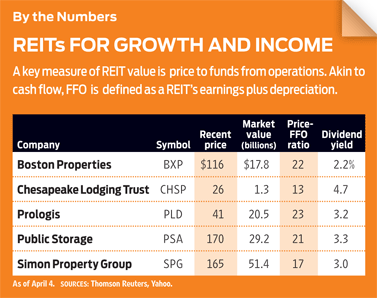REITs Making a Comeback
After a horrible 2013, conditions are looking brighter for real estate investment trusts. These five have good prospects.
Like bonds, real estate stocks struggled last year when the Federal Reserve began to unwind its easy-money policies. The average property-owning real estate investment trust returned just 2.5% in 2013, trailing the overall stock market by 30 percentage points.
But a combination of gently rising interest rates and gradual economic growth isn’t the worst thing for REITs, which can raise rents and benefit from improving property values. Since 1993, there have been eight stretches of 12 months or longer when yields on ten-year Treasury bonds climbed by at least a half-percentage point. During those periods, REITs returned an average of 14.8%, according to Cohen & Steers, an investment shop that specializes in real estate stocks.
The situation is playing out similarly this year. Year to date through April 4, REITs surged 10.6%, compared with a return of just 1.4% for Standard & Poor’s 500-stock index. Those figures include dividends, and that is important because REITs are known for delivering high income. In fact, to qualify for REIT status, a company must pay out at least 90% of its taxable income to shareholders. The average property REIT yields 3.9% today.

Sign up for Kiplinger’s Free E-Newsletters
Profit and prosper with the best of expert advice on investing, taxes, retirement, personal finance and more - straight to your e-mail.
Profit and prosper with the best of expert advice - straight to your e-mail.
REITs are not particularly cheap today. The average ratio of REIT share prices to funds from operations (the industry’s preferred measure of profits) stands at 16, up from the average since 2000 of 15.
So what should you do? Most advisers suggest allocating 5% to 10% of your total portfolio to REITs because real estate stocks don’t always move in tandem with the broad market. If you need to build up that allocation, stick with REITs that own properties with potential for appreciation and are in a good position to boost rents. Here are five attractive candidates.
Upscale hotelier. Lodging REITs have a lot of flexibility when it comes to raising rents because operators can change rates overnight. That advantage has not been lost on investors: Hotel REITs led the pack in 2013, with an average return of 27%. This year, demand for rooms is expected to be strong, while fewer new hotels are opening for business than in 2008. Those factors should continue to boost lodging REITs, such as Chesapeake Lodging Trust (symbol CHSP). The REIT owns 20 upscale hotels in major U.S. cities, such as New York, Chicago and San Francisco. It is renovating three of its properties this year, but even counting those hotels as out of commission, the Annapolis, Md.–based REIT expects average revenue per room to rise by as much as 5.5%, about on par with the industry. Meanwhile, the stock trades at a reasonable 13 times estimated funds from operations.
The rise of online shopping has hurt malls across the nation. But analysts say that some high-end shopping centers can withstand the onslaught of technology. “These class-A malls sell an experience you can’t get online,” says Marc Halle, a senior portfolio manager at Prudential. As such, he argues, firms that specialize in top-tier malls offer rare value in the REIT sector today.
One of the best examples is Simon Property Group (SPG). The company, based in Indianapolis, owns 156 malls, including Copley Place in Boston and The Galleria in Houston, as well as 66 Premium Outlet shopping centers across the country. Simon also has interests in properties abroad. Last year, occupancy grew from 95.3% to 96.1%, and the firm was able to increase rents by an average of 4%. New mall development will be limited in the next few years, which should allow Simon to raise rents, says S&P Capital IQ. And the stock commands only a slight premium to the market, trading at 17 times estimated FFO.
Even though some malls are doing well, it’s hard to deny the growth of e-commerce. To ride that end of the shopping wave, consider Prologis (PLD). The San Francisco-based REIT owns and manages 569 million square feet of distribution facilities that it leases to retailers, logistics providers and transportation companies, among others, in 21 countries. The economic recovery, albeit slow, is helping fuel demand for that space. Occupancy rates grew from 94.0% in December 2012 to 95.1% by the end of 2013, and rates could edge up as much as another percentage point this year. As space tightens, property values should rise. Research firm Green Street Advisors says industrial property values are still an average of 1% below their 2007 peak. Prologis forecasts that rents will rise by as much as 25% over the next four years.
With such bright prospects, Prologis does not come cheap. The stock trades at 23 times estimated FFO and may be ripe for a temporary drop. If its price falls by, say, 10%, pounce.
As consumers shop, they may need to put some of their old stuff into storage. Until a few years ago, the storage business was largely made up of mom-and-pop shops. Now, the industry is consolidating, and Public Storage (PSA), the largest player, stands to benefit. At last count, Public Storage had 2,200 locations in 38 states, as well as 188 properties in Western Europe. The Glendale, Cal.-based REIT has developed a strong brand that attracts new customers. Last year, occupancy rates climbed from 91.9% to 93.3% (based on facilities that had existed for at least one year), allowing the company to boost rents by 5.4%. Plus, few developers are building new locations. “The spaces can take a while to lease up and, as a result, can be difficult to get financing to build,” says Jason Yablon, a portfolio manager at Cohen & Steers.

The stock trades at 21 times estimated FFO. So, as with Prologis, you may want to wait for a pullback of, say, 5% to 10% before you buy.
Office buildings may not seem like a high-growth area because a slow job market has kept national vacancy rates high. According to Reis, which keeps tabs on the commercial real estate market, the rate nationally was 16.9% at the end of 2013, only 0.2 percentage point lower than it was at the end of 2012.
But as with everything in real estate, location matters. In New York City, for example, the vacancy rate was only 9.9% at the end of last year. So office REITs with a foothold in low-vacancy areas should do well. Boston Properties (BXP) has buildings in five prime locations: Boston, New York, San Francisco, Princeton, N.J., and Washington, D.C. The Boston-based REIT isn’t having trouble attracting tenants. Occupancy rates at the end of 2013 stood at 93.2%, up from 91.1% a year earlier.
Analysts say the stock, which trades at 22 times estimated FFO, could rise as new developments are completed in coming years and investors reward the REIT for Boston Properties’ presence in key markets.
If you’d rather have a pro pick the stocks, you can choose from a number of solid funds. Morningstar analyst David Kathman favors Fidelity Real Estate Investment (FRESX). The fund charges 0.81% in annual fees (the category average is 1.33%). Steve Buller, who has managed the fund since 1997, screens stocks based on property values and rent growth, but also looks at so-called technical indicators, such as a stock’s price history. Over the past 15 years, the fund returned 11.5% annualized, compared with 10.8% for the typical real estate fund.
Another possibility: T. Rowe Price Real Estate (TRREX). Manager David Lee, in charge since 1997, tends to buy REITs that trade at a discount to the value of their properties. The fund charges 0.79% and has delivered an annualized return of 12.0% over the past 15 years.
For a lower-cost option, consider Vanguard REIT Index (VNQ). The exchange-traded fund, which launched in 2004, charges a rock-bottom 0.10% annually.
Get Kiplinger Today newsletter — free
Profit and prosper with the best of Kiplinger's advice on investing, taxes, retirement, personal finance and much more. Delivered daily. Enter your email in the box and click Sign Me Up.
-
 80-Year Old Dick Durbin, the Senate’s No. 2 Democrat, To Retire After 44 Years in Congress
80-Year Old Dick Durbin, the Senate’s No. 2 Democrat, To Retire After 44 Years in Congress‘In my heart, I know it’s time to pass the torch,’ Senator Durbin said in a statement.
By Kathryn Pomroy
-
 Stock Market Today: Stocks Rise on Good Volatility
Stock Market Today: Stocks Rise on Good VolatilityInvestors, traders and speculators continue to process the "known unknown" of global tariff-and-trade war negotiations.
By David Dittman
-
 Why Is Warren Buffett Selling So Much Stock?
Why Is Warren Buffett Selling So Much Stock?Berkshire Hathaway is dumping equities, hoarding cash and making market participants nervous.
By Dan Burrows
-
 If You'd Put $1,000 Into Google Stock 20 Years Ago, Here's What You'd Have Today
If You'd Put $1,000 Into Google Stock 20 Years Ago, Here's What You'd Have TodayGoogle parent Alphabet has been a market-beating machine for ages.
By Dan Burrows
-
 Stock Market Today: Stocks Retreat Ahead of Nvidia Earnings
Stock Market Today: Stocks Retreat Ahead of Nvidia EarningsMarkets lost ground on light volume Wednesday as traders keyed on AI bellwether Nvidia earnings after the close.
By Dan Burrows
-
 Stock Market Today: Stocks Edge Higher With Nvidia Earnings in Focus
Stock Market Today: Stocks Edge Higher With Nvidia Earnings in FocusNvidia stock gained ground ahead of tomorrow's after-the-close earnings event, while Super Micro Computer got hit by a short seller report.
By Karee Venema
-
 Stock Market Today: Dow Hits New Record Closing High
Stock Market Today: Dow Hits New Record Closing HighThe Nasdaq Composite and S&P 500 finished in the red as semiconductor stocks struggled.
By Karee Venema
-
 Stock Market Today: Stocks Pop After Powell's Jackson Hole Speech
Stock Market Today: Stocks Pop After Powell's Jackson Hole SpeechFed Chair Powell's Jackson Hole speech struck a dovish tone which sent stocks soaring Friday.
By Karee Venema
-
 Stock Market Today: Stocks Drop Ahead of Powell's Jackson Hole Speech
Stock Market Today: Stocks Drop Ahead of Powell's Jackson Hole SpeechSentiment turned cautious ahead of Fed Chair Powell's highly anticipated speech Friday at the Jackson Hole Economic Symposium.
By Karee Venema
-
 Stock Market Today: Stocks Rise After Jobs Data Lifts Rate-Cut Odds
Stock Market Today: Stocks Rise After Jobs Data Lifts Rate-Cut OddsPreliminary data from the Bureau of Labor Statistics shows job growth was lower than previously estimated.
By Karee Venema